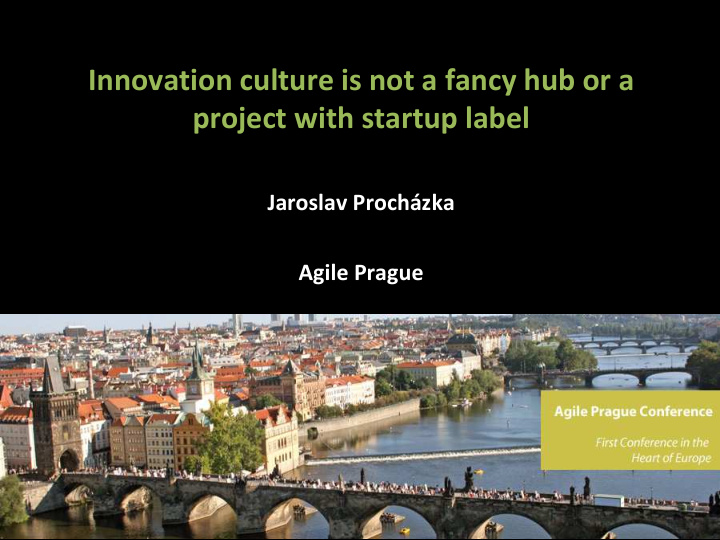



Innovation culture is not a fancy hub or a project with startup label Jaroslav Procházka Agile Prague
About me • Agile coach and mentor • Innovation mentor • (e-)book author • Co-founder of QuickJOBS and SimplyIT.cloud • Co-founder of Viva incubator • Mentor in JIC, GreenLight, iKid Blog: www.differ.cz Twitter: @JarekProchazka https://twitter.com/JarekProchazka
Agile is not a SW development approach … … it is a company organizational and cultural change … and innovation culture and management is its part
Therefore need to be … supported by business driven by business done together with business … … and with people (employees, customers)
Software development Engineering disciplines and Agile approaches (5000+ years) (50+ years)
Still evolving …
Phase 1: internal cleaning (behind the wall) … ( Guerrilla) Agile implementation only in IT teams Iterations, engineering practices (pair working, code review, automation, UC/US, TC, CI) Be more efficient , quick , have better quality, predictability and internal visibility
Phase 2: Dismantling the wall… US with clear business value /benefit Early and frequent customer involvement Contract updates Regular Demo Measuring the success and visibility for the business/customer
Phase 3: IT part of the business… Tight cooperation between IT and business (cross teams, Agile business teams) Agile contracts Measuring the success (company boards) Discovery process / dual track Agile (here the business innovations appear!)
Phase 4 Driving the business… (Strategic/Business Agile): Managers as organizational coaches Hiring based on values (HR) Management as one team Agile procurement à vendor ecosystem (Agile RFP) Incremental innovations part of daily business Future horizon: Internal startups, LABS, new markets, products/services
McK: 3 Horizons Unknown Business Model • Different mindset needed • Ideally ( startup , R&D ) 70-20-10% Need to be verified • spread Verified new products • Emerging, core product complement • Incremental / verified disruption • Existing core products/services • (key business) Focus on defend and optimise • Incremental changes •
Simon Wardley: 3 party system
Takes time to create Internal start-ups the organizational change mindset of innovation skills organization (start now, experiment) Also fail is a success , learning Bias , bureaucracy , no time and uniformity as biggest (we DON’T do what innovation blockers nobody would buy)
What type of company is yours? Source: https://marketoonist.com/2007/02/new-product-adoption.html
Initial experiments to take Deliver incremental innovations • Conduct regular demos • Run FedEx day • Measure and visualize E2E • (NPS, product usage!) Invite startups (talks, presentations) • Conduct internal innovation conference • Share user feedback and NPS results • SM: shift from team coach to organization • & mgmt. coach PO: experiment, verify, prototype • Visualize what you know now • (data, facts, not assumptions) Explain 3 horizons •
Anti-pattern - possible steps
Explicit „NO“ and lacking focus “Show me your business case” even before small experiment Do it as part of your daily (overwhelming) operations! Steps: Grant people limited time for • experiments (e.g. 10%, FedEx days, hackathons) (Partly) Fully dedicated teams • Innovation process to gather ideas • Organize hackaton , FedEx day or • Design Sprint
HIPPO / confirmation bias I know what they want! I think/assume/like ... We have this market research … Steps: Clarify and visualize product/ • service vision (LC/BMC/Product vision board) Start to say NO as PO • Conduct small internal • experiments Show current usage data • (NPS, product usage, heat maps, word clouds from feedback)
Everybody innovative! They do not innovate, they just do their daily operations... Wrong assumptions behind: • All people are the same • All teams have the same goal and context (product, dev, maintenance, support, … ) Steps: • Explain 3 horizons of business and different types of innovations • Explain and respect people typology (only few like changes) • Demonstrate your (personal, team) specific value and skills • Don’t forget to focus on H1! This is your core business
External innovation agencies They will create the innovation for us (as this is granted and less risky) We will hire external people to do innovations Steps: Build internal competence • Involve internal employees in • innovation agency projects (to change their mind & teach them the techniques, tools) Mix internal & new hires • Question status quo • (processes, handovers, roles, … )
Innovation without (working/ verified) Business Model This technology is great! Let’s release it, we will think about money later Consider Twitter , Tesla, Google Glass Steps: Think about all 3 parts: customer • needs – solution – BM Verify also/mostly BM • Monetize since the first MVP •
“We-them” culture These old style folks! Those innovation junkies have always some benefits (better rooms, free snacks, … ) Steps: Realize that your company is also • your customer ! Focus on communication • (blogs, video, internal magazine) Share your findings • (personas, needs, feedback, figures) Open demos regularly •
Blog: www.differ.cz Twitter: @JarekProchazka https://twitter.com/JarekProchazka LinkedIn: https://www.linkedin.com/in/jaroslav- procházka-6a65b14/ e-book on internal startups (50 pages, 8 MB): goo.gl/4hZzxZ
Recommend
More recommend